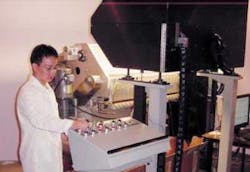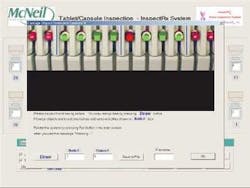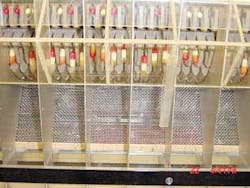Synchronized camera system tracks pill bottles
Camera system ensures accuracy in color consistency, shape, and defect detection during pill bottling.
By Sabrie Soloman, Sheng Ma, and Tao Li
In pharmaceutical bottle-filling operations, pills (caplets, capsules, or tablets) must be manually loaded into a machine through guide slats that contain recessed cavities intended to hold the pills and then fed into bottles. As the pills are loaded into a slat-filling machine, they fill the cavities of several slats. A series of vibratory actuators and rotating brushes ensure that the pills fill a majority of the cavities in every slat. However, a few cavities may not be filled, resulting in underfilled bottles. US Food and Drug Administration (FDA) regulations require that the product count in each bottle be the exact count specified on the label.
To ensure an accurate count, operators observe the filling of each slat immediately before dispensing the pills into the bottles. This method has proven unsatisfactory because of human error in observing pills in cavities. Production lines must be slowed to allow the operators adequate time to observe an entire row of cavities. Another method combines manual observation with a 2%–5% oversupply of pills per bottle, which reduces productivity. However, neither of these methods prevent broken or misshaped pills or foreign objects from entering bottles.
To improve its pharmaceutical-inspection operations, McNeil Consumer Healthcare (Fort Washington, PA, USA), a division of Johnson & Johnson, asked American SensoRx (Glen Rock, NJ, USA) to develop an automated vision system. The resulting InspectRx vision system compensates for underfilled bottles, rejects bottles with broken or misshaped products, and shuts down the production lines in case of foreign objects. It is designed to inspect any cavity size of any type of pharmaceutical bottle-filling machine, which may contain from a few cavities to a few hundred cavities per slat (see Fig. 1).
null
Hardware configuration
The InspectRx system contains 10 Pulnix (Sunnyvale, CA, USA) TMC-9700 2/3-in. progressive-scan full-frame cameras. Each camera is responsible for viewing a preassigned number of pills. A proprietary subpixel technique enhances resolution by 10 times greater than that provided by the standard 768 x 484- pixel CCD. The optics for the system are C22525-25CM f/1.4 lenses from Cosmicar/Pentax (Tokyo, Japan). American SensoRx developed the lighting using standard fluorescence lights and its own transformer to raise the frequency from 60 to 288,000 Hz of cool light.
Each camera has a Matrox (Dorval, QC, Canada) Meteor-II frame-grabber board inserted in a PCI-X 100-MHz/64-bit base that digitizes the captured images. Proprietary software routines enhance and analyze the images, rendering a data-matrix thread, which is a means of seamlessly linking data files from different computers so that they are stitched together. Ten cameras render 10 threads of data-matrices, providing accurate status of 1960 pills per second per cycle. The cycle in this case consists of 10 slats, with each slat containing 196 pills for inspection.
When the threads are sequenced and stitched together, the software routines accurately correlate the number of objects within each thread with a bottle placed at the end of a slat chute. The system accumulates the total number of pills per thread per cycle, tracing the accumulated count of units per bottle and producing a correctly filled or an underfilled bottle.
null
For each underfilled bottle, proprietary routines developed by American SensoRx send a signal to a National Instruments (Austin, TX, USA) NI 6527 digital data-acquisition board to generate a reject signal, which can be set to trigger at varying numbers. When the underfilled bottle leaves the work area, it is traced and electropneumatically transferred to an accumulating conveyer for correction. Each underfilled bottle receives compensating caplets, capsules, or tablets to produce the required count in each bottle. For misshaped, broken, or grossly underfilled bottles, the system electropneumatically diverts them to a chute for rework. When a foreign object is detected, the line can be shut down for audit and investigation.
Multithreading
The InspectRx vision system is divided into segments that consist of a single camera connected to a frame grabber (see Fig. 2). In the McNeil equipment, 10 frame grabbers reside in three integrated IBM (Armonk, NY, USA) 240-Gbyte IntelliStation Z Pro multiprocessors. These workstations have an accelerated graphics port—the Matrox Millinium G450 4X with 32 Mbytes double data rate (DDR)—and run Intel (Santa Clara, CA, USA) Xeon processors with 8 Gbytes of RAM. One of the IBM workstations contains only two dual frame grabbers with a dual inline memory module (DIMM), while the other two workstations contain four DIMMs with four frame grabbers each.
null
The workstation with two dual frame grabbers is used as the main processor to carry out communications with peripheral equipment such as the electropneumatic mechanisms. External input/output are achieved through separate NI 6527 data-acquisition boards in the workstation, each with 24 inputs and 24 outputs. Communication between the cameras and workstations is over quick-disconnect video cables with Hirose connection from TKM Technologies (Port Jefferson, NY, USA). The cables can reach up to 50 ft and are critical in preventing high noise levels in the signal.
Each camera images a specified number of exiting pills, varying from 8 to 20 depending on the type of slat-filling machine. The system produces 10 threads of data matrices from the 10 cameras, which have captured images of 10 cavities per slot each. The thread carries the exact status of each pill falling from its cavity.
Each thread takes the data of each segment and writes the information in a temporary file. The system synchronizes the data sent to the separate 10 temporary files and renders a decision within 3.5 ms regarding the status of the exact count per bottle, the validity of product color combinations, the integrity of each pill, and any foreign objects. The system then resets the threads and deletes the 10 temporary files to commence another inspection cycle. The software continuously displays the status of operations, and, with its neural-network algorithms, allows the operator to analyze entire slats or groups of slats at one time (see Fig. 3).
Detecting defects
When a foreign object is detected, the system shuts down the main production machine. The InspectRx system then automatically brings up a screen to guide the operator to the exact location of the foreign object. It also records operator's name, cause of error, and type of error and enters a time-stamp complying with US FDA CFR 21-Part 11. The main operating screen provides the status of each filled bottle. When the system captures the image of the product in the field of view, it determines if the pill is partially broken or if it is a foreign object.
The system also captures pills in mid-air, where it can identify broken pills or pills that are migrating from one bottle domain (slat-chute-bottle) to another (see Fig. 4). For example, as the vibrator in the bottle-filling machine and the rotating brush are activated, they frequently generate excessive inertia, which can pull pills out of designated cavities and into other chutes, causing underfilling in one bottle and overfilling in another.
null
To perform the precise task of directing 10 cameras to the exact x,y,z coordinates for each type of caplet, capsule, or tablet, the system is equipped with an automated, computer-controlled motorized lift mechanism built by American SensoRx The control software stores the x,y,z coordinates of each family of products; for example, caplets of almost the same configurations and sizes would share a specific camera coordinate location above the slats of the production machine. Round tablets of different products could share the same camera coordinate location.
Once the specific pill product is selected, the InspectRx system lifts and moves the cluster of 10 cameras to a preprogrammed location from which to image the slats. The automated lift mechanism is equipped with an encoder capable of tracking or reaching the exact x,y,z coordinate for the camera cluster above the slats.
This reprogrammable automated motion procedure illustrates the versatility of the system, which can be reconfigured and reprogrammed to operate in numerous machine-vision and robotic-guidance applications. It has already been adapted to other applications, such as the inspection of catheters for microflaws and determination of the weight and quality of beef, pork, and poultry.
SABRIE SOLOMAN is chairman and CEO, SHENG MA is vision engineering manager, and TAO LI is senior vision software engineer at American SensoRx, Glen Rock, NJ, USA; www.americansensorx.com.
COMPANY INFO
American SensoRx www.americansensorx.com
DT Industries www.dtindustries.com
IBM www.ibm.com
Intel www.intel.com
Matrox www.matrox.com
McNeil Consumer Healthcare www.mcneilcanada.com
National Instruments www.ni.com
Navitar www.navitar.com
Pulnix www.pulnix.com
TKM Technologies www.tkmtech.com




